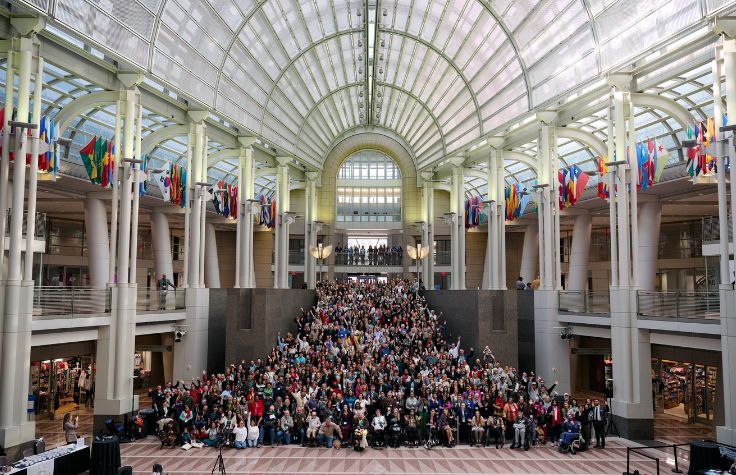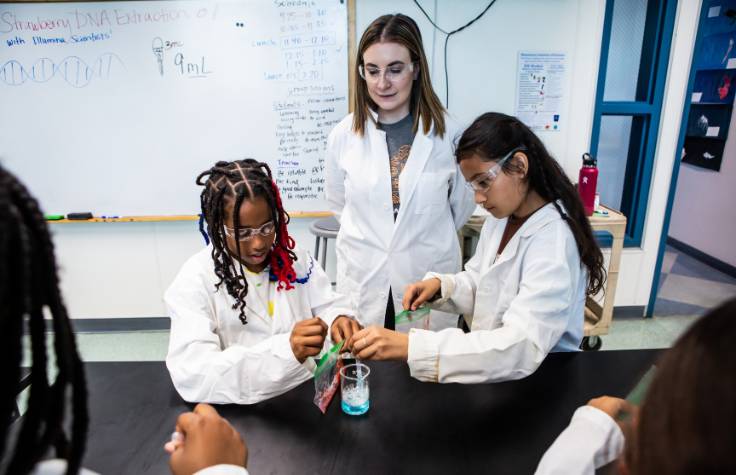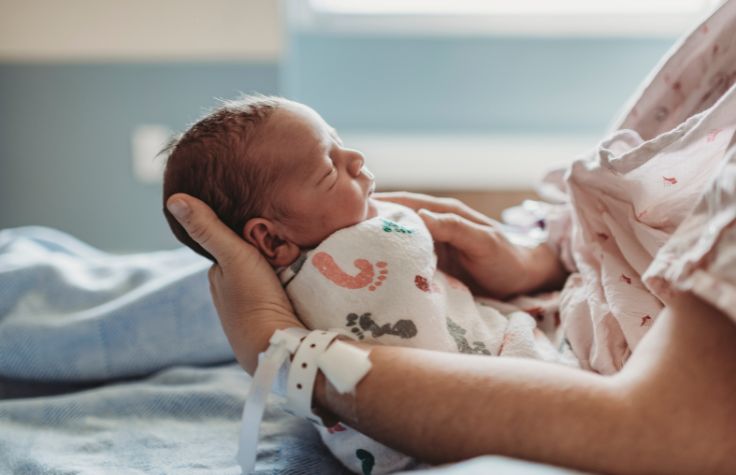
March 11, 2024
Young Adult Rare Representatives, or YARR, is a program that empowers rare disease patients in the United States, ages 16 to 30, to advocate for health care and policy reform. Courtney Felle, 24, serves as the YARR program manager. “I think there’s something really special about having a young adult with a rare disease managing a program for young adults with rare diseases,” says Felle, who assumed this responsibility in 2021. She supports YARR members in myriad ways, performing outreach, matching members to speaking engagements, and connecting them to opportunities in the community. She runs multiple training programs throughout the year and helps members prepare to meet with legislators. At every instance, she seeks to break down difficult policy issues as well as ensure that young adult feedback is included in policy creation and advocacy.
YARR’s umbrella organization is the EveryLife Foundation for Rare Diseases, now celebrating its 15th year and making an impact in Washington, DC, during Rare Disease Week 2024. We spoke with Felle to learn more about EveryLife and YARR activities, the current state of health care in the US, and living with a rare disease.
First, tell us about the EveryLife Foundation.
The EveryLife Foundation essentially has two arms. One arm does public policy work on both the federal and the state levels in the United States. That includes anything regarding the development of or access to treatments for rare diseases, and adjacent policy areas such as newborn screening and diagnostic access. The advocacy arm has programs that are designed to get advocates talking directly to their legislators, such as the Rare Disease Legislative Advocates (RDLA). We like to say we don’t speak for patients; we get patients in the door.
How do you identify the opportunities or prioritize certain policies over others?
Within the EveryLife policy arm, we have our Community Congress, which is our working group of stakeholders in the rare disease community in the United States. It’s a mix of patient organizations, such as the VHL Alliance or Parent Project Muscular Dystrophy, as well as industry members, payers, and research groups. In quarterly meetings, we talk about upcoming bills that folks are working on, and what are all the issues and gaps that different organizations are seeing. How can we all talk about those issues together so that every group isn’t introducing their own legislation on a similar issue, but we’re bringing forward the most comprehensive solution?
What’s one bill you’re working on?
Right now, one example that is a community-chosen ask for Rare Disease Week 2024 is the Safe Step Act. It would help set up reform and exception pathways to something called “step therapy.” Step therapy is when an insurance company won’t cover the medication your doctor just prescribed because they mandate that you try medication A or medication B or medication C before you can take this actual appropriate medication. I’ve had this happen to me personally, too. It is frustrating when you and your provider both know you need to take a specific medication, but insurance providers implement barriers. The Safe Step Act would affect many people with chronic illnesses, including ones that are not rare, but step therapy tends to hit rare patients particularly hard because there often aren’t well-established standards of care. Insurance companies often aren’t as familiar with that condition or with other patients who’ve taken different medications. Thus, the Safe Step Act would create exception pathways for patients to be able to get onto the medication they need to take sooner—and not have to spend all the time, money, and potential symptom progression currently involved—based on conditions including treatment contraindication, expected side effects, or preventable disease progression.
So why are teenagers and twentysomethings powerful advocates? What does generation Z bring, specifically?
Young adults know what it’s like to be a young adult with a rare disease. They talk amongst each other. They know the shared issues and potential solutions. But they are, as a group, often left out of policy discussions. They need opportunities to translate their lived experience to policymakers, because otherwise, those creating policies and implementing regulations cannot understand the true, full needs of the young adult population.
What’s an example of a barrier that young adults are facing?
In the United States, you have the specific transitional period from seeing pediatric providers to adult providers, as well as the switch to your own insurance plan from your parents’, or from Medicaid or CHIP [Children’s Health Insurance Program] to an adult public or private insurance program. That transition can create drop-off points that disrupt young adults’ health care and pose significant physiological, psychological, and social challenges. There’s a lot more we can do to support young adult patients in their transitions.
What was your diagnostic odyssey like with hypermobile Ehlers-Danlos syndrome, or hEDS?
At first, doctors were very dismissive of my symptoms. I started seeking out care at 13, but I made it all the way to college undiagnosed with only piecemeal treatment. As a college junior, I was receiving accommodations based on symptoms alone, and I was trying to find a scientific way to say “wiggly wrists” on my administrative paperwork, so I could use my laptop in classes. I came across EDS forums, and something clicked. A few months after that, my neurologist actually brought up EDS to me. That diagnosis was incredibly helpful to know what I should and shouldn’t be doing. EDS has 13 subtypes, and 12 of those subtypes have genes identified. The one that does not is hypermobile EDS, which is the most common. There’s research happening, but it’s complicated. Diagnosis was a big, helpful step, but it was only one step.

What are some of the care gaps the rare disease community experiences?
A lot of folks don’t realize how few rare diseases have appropriate and approved treatments. Around 95% of rare diseases do not have an FDA-approved treatment. There is a lot of off-label medication use, if and when there are medications that are appropriate to use. Even then, when you do have doctors who are trying their best, there’s sometimes only so much they can do because they’ve hit the limit of medical knowledge. What’s also difficult within the United States is the federalized system of how you can or cannot see certain doctors across state lines, or according to your insurance provider.
You’ve written about visibility, and how the world doesn’t often let you be both public and safe. Can you talk about that?
I use various mobility aids. The way that hEDS affects my joints has moved to my hips and knees. Sometimes I use a cane. Sometimes I use forearm crutches. And I have a travel power wheelchair that I’ve nicknamed “Pepper” because it’s peppermint green and gives me extra energy, or pep. Able-bodied people don’t need to think about everything that goes into using a wheelchair. I am very visible as someone with a rare disease or disability. I can have a meaningful day of advocacy, like during Rare Disease Week, where I present to YARR members, or speak to my legislator directly, or advance policy and regulatory priorities that would help patients, and I feel like I’m creating this really positive impact. And then I go to take the Metro home, and the elevator’s still broken, or someone says something weird like, “Oh, you’re so young to be using a wheelchair.” Those events have to coexist on the same day. I wish I could move through the world and not have to deal with a lot of this, but also because I do, I want to talk about it. I want to advocate. I want to be public about it.
What are a few things about rare conditions and disability that most people don’t know?
In 2021, the EveryLife Foundation published the National Economic Burden of Rare Disease Study, including patient survey data from 379 rare disease communities. We found that the average time to diagnosis in the US is 6.3 years. And the average number of specialists you see is 16.9 throughout those years. I’ve talked to people who went 20, 30, or 40 years without a proper diagnosis, and I think people on the outside of the rare disease world often don’t understand that feeling of knowing something is wrong, but not knowing what and not necessarily having doctors have the knowledge, or the tools, or sometimes the inclination to figure out what’s wrong. The diagnostic odyssey is extremely complicated. The journey has so many twisting roads, so many loops backwards. It’s not clear-cut.
16.9 specialists! And so much time taken out of school, driving to the doctor…
Exactly! As a kid, it was time that my mom had to take away from work to drive me and a lot of money for copayments. In the National Economic Burden of Rare Disease Study, we address absenteeism, but there’s also something that we call “presenteeism,” which is when you’re technically at work or school but you’re so distracted by your symptoms or by the diagnostic journey that you’re not fully present or fully productive. There were definitely a lot of times when I was not able to commit to a school project or a school club or other social things that kids are supposed to do because I was preoccupied with trying to deal with the chronic illness I had, and also the fact that I didn’t know what I had. That not knowing is really, really expensive. We found that the cost in the United States alone was just under a trillion dollars in 2019.
If we could diagnose patients properly sooner, it would save so much money for patients and families as well as larger social systems and insurance providers. We worked with the same health economics team, the Lewin Group, on another study more recently. It was on The Cost of Delayed Diagnosis in Rare Disease. It uses the same data from the National Economic Burden of Rare Disease Study and available health care utilization data. It addresses that added cost of not properly diagnosing a condition at the time of onset or symptom presentation. We used a lot of examples from newborn screening in the United States, because there’s a really clear pathway of what happens when you are diagnosed as a newborn versus later in life. We looked at the avoidable health care costs as well as indirect costs, like transportation or missing work, compared to if you’d had a diagnosis at first symptom—not if you had been born healthy or able-bodied. The avoidable costs per patient with delayed diagnosis are up to $517,000 over the 6.3-year average diagnostic delay. It is absolutely wild. Every time I look at the study, I feel empowered that we created it, but also just deeply sad.
There is so much work to be done. How do you stay positive?
I have seen bills pass or regulations get implemented that are genuinely helpful for rare disease patients in their daily lives. Even for smaller-scale wins, if I help even three people get access to treatment that they otherwise wouldn’t have—someone is alive because of that advocacy. Those wins are important to remember. It is absolutely better than the world without that advocacy. And you just work on it. You all work on it together. I like to think of it as a big tapestry where you’re all weaving one part of it, but it’s still that bigger picture that’s in motion. No one can do it alone.
What did YARR plan for Rare Disease Week?
EveryLife and YARR held a series of events that involved bringing advocates together to discuss key policy issues and educate each other on advocacy. We also brought folks directly to Capitol Hill on Tuesday, February 27. We do a documentary screening every year to kick off Rare Disease Week. Later in the week, we hosted a Rare Disease Congressional Caucus briefing as well as a reception for some of our Rare Artist winners who created really wonderful art about living with a rare disease. YARR does a Young Adult Meetup every year, and we have a legislative breakout session at the larger Legislative Conference that prepares advocates for their Hill meetings. We discuss the importance of young adult advocacy and the young adults’ chosen policy priorities—this year, “Ensuring Access to Approved Treatments.” We have two YARR members who speak at our legislative breakout session every year. This year, it was Rachelle Cook and Sophie Melancon (who is only 16 years old!).
How can people learn more about YARR and get involved?
YARR has programming year-round. People can apply any time of the year. Between annual Rare Disease Weeks, we hold virtual activities. There’s a big event with legislators in August, Rare Across America, which includes Zoom meetings with senators and meetings in-district with House members. We do monthly Zoom meetings open only to YARR members, public speaking trainings through our Speakers Bureau, next-level leadership training through the YARR Leadership Academy, and other events based on young adults’ feedback. If anyone has questions about what YARR does or how to get involved, you are more than welcome to email me at cfelle@everylifefoundation.org.


